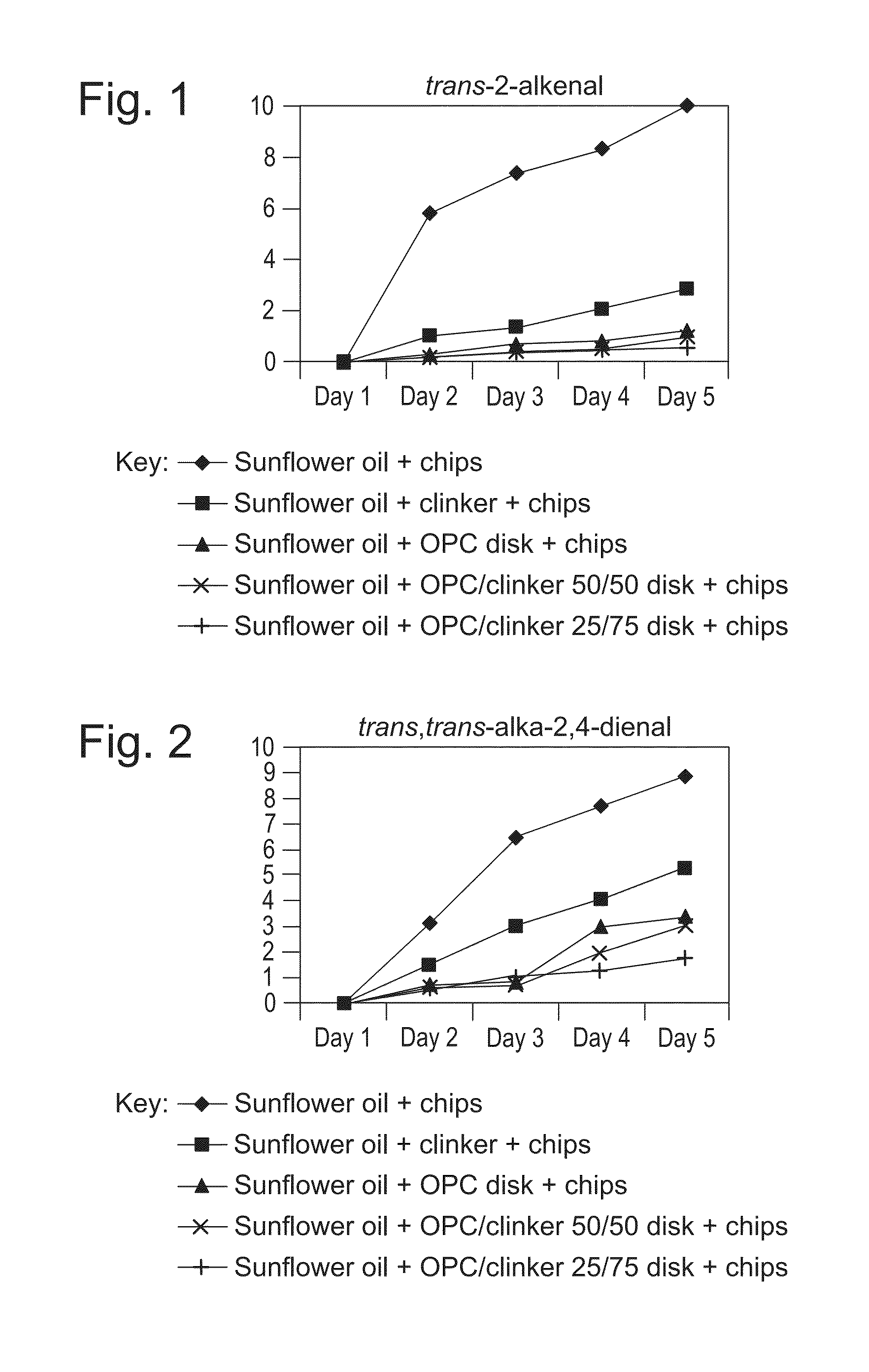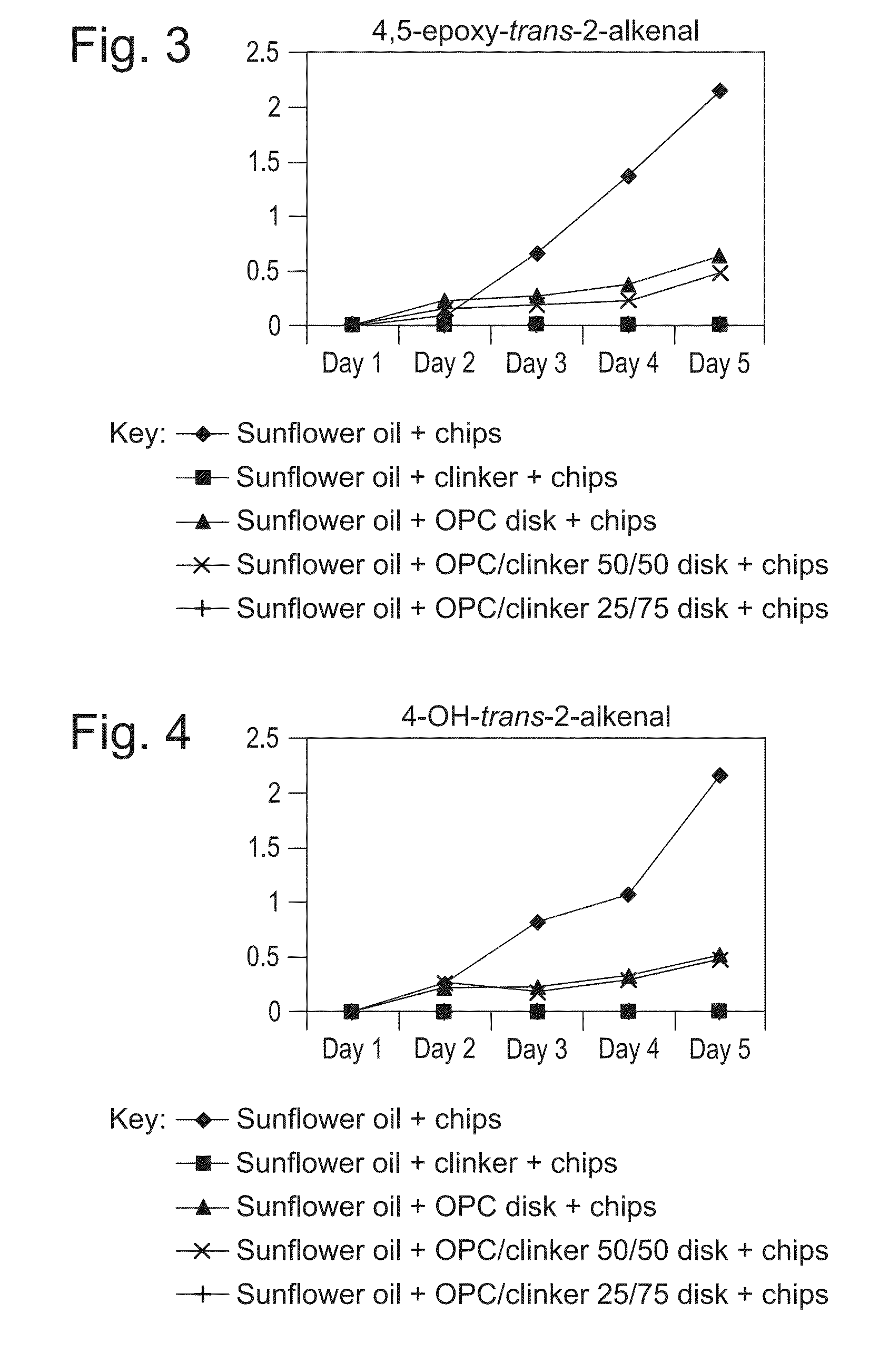Hydraulically set cement body for preservation of organic liquids
a cement body and oil-permeable technology, applied in ceramicware, other chemical processes, separation processes, etc., can solve the problems of contaminating the oil, affecting the preservation effect, and affecting so as to achieve the effect of increasing the concern of contaminants in cooking oil, reducing the quality of organic liquids, and reducing the quantity of organic liquids
- Summary
- Abstract
- Description
- Claims
- Application Information
AI Technical Summary
Benefits of technology
Problems solved by technology
Method used
Image
Examples
example 1
Cement Clinker and OPC
[0076]Aalborg White Cement Clinker and Aalborg White OPC are materials available from Aalborg Portland Group of Denmark Aalborg white OPC is produced from extremely pure limestone and finely-ground sand. It has a low alkali (Na2O) content of 0.2-0.3 wt %, a low tricalcium aluminate (C3A) content of 4-5 wt % and a chromate content of not more than 2 mg / kg.
[0077]The white cement clinker as supplied had a particle diameter of 8 mm, an analysis of SiO2 25.0%, Al2O3 2.0%, Fe2O3 0.3% and CaO 69.0%, and a Bogue composition of C3S 65.0%, C2S 21.0%, C3A 5.0% and C4AF 1.0% wherein C3S represents tricalcium silicate Ca3SiO5s, C2S represents dicalcium silicate CaSiO4, C3A represents tricalcium aluminate Ca6Al2O6 and C4AF represents tetracalcium alumino-ferrite Ca4Al2Fe2O10. The white cement clinker had a surface area of 0.43 m2 / g, porosity of 37% and density of 1.1. It was effective to remove free fatty acids, aldehydes and other contaminants from oil, and gave rise to the...
example 2
Experiments on Beef Dripping
[0102]An “aldehyde cocktail” was created by adding three of the main aldehydes (trans-2-alkenals, trans, trans-alka-2,4-dienals, and n-alkanals) to beef dripping (500 g) so as to have a typical aldehydic concentration of 10 mmol / kg dripping (ca. 2 mmol / kg dripping in the case of cis,trans-alka-2,4-dienals, reflecting its typical distribution in a trans, trans—alka-2,4-dienal sample).
[0103]A filter disk (either OPC—filter 1 or OPC / clinker 50 / 50—filter 2, typical disk weight 35 g) was placed in the dripping, the oil then being allowed to attain an optimum cooking temperature of 180° C. through the use of an electronic hotplate. Where appropriate (see below), 90 g of potato chips was then added to the hot fat and cooked until “brown”. They were then removed and replaced with fresh chips of the same weight, this being repeated so as to give a total number of fries per day of 8. A total of 2 days frying was performed. After each days frying regime, a sample of...
example 3
Experiments Using Sunflower Oil / Eliadic Acid
[0105]Direct heating of a small sample of the trans fatty acid elaidic acid led to the acquisition of an NMR spectrum that showed significant levels of trans-2-alkenals and n-alkanals, not unexpected for a monounsaturated fat (with the proviso that trans converts to cis upon heating).
[0106]Tests were conducted on sunflower oil that had a sample of elaidic acid added, with subsequent frying of potato chips. The experimental procedure was the same as that employed in the previous examples with the exception that 0.5 g of elaidic acid was added to 400 ml of sunflower oil (giving a concentration of ca. 4 mmol / kg oil). One set of tests featured just this mixture whilst the other also included the addition of a 25 / 75 ratio OPC / clinker filter disk. Analysis of the sunflower oil sample spectra highlighted heightened levels of trans-2-alkenals and n-alkenals, consistent with a degree of conversion of elaidic acid to these two aldehydic species. Mea...
PUM
| Property | Measurement | Unit |
|---|---|---|
| Length | aaaaa | aaaaa |
| Mass | aaaaa | aaaaa |
| Mass | aaaaa | aaaaa |
Abstract
Description
Claims
Application Information
 Login to View More
Login to View More - R&D
- Intellectual Property
- Life Sciences
- Materials
- Tech Scout
- Unparalleled Data Quality
- Higher Quality Content
- 60% Fewer Hallucinations
Browse by: Latest US Patents, China's latest patents, Technical Efficacy Thesaurus, Application Domain, Technology Topic, Popular Technical Reports.
© 2025 PatSnap. All rights reserved.Legal|Privacy policy|Modern Slavery Act Transparency Statement|Sitemap|About US| Contact US: help@patsnap.com



